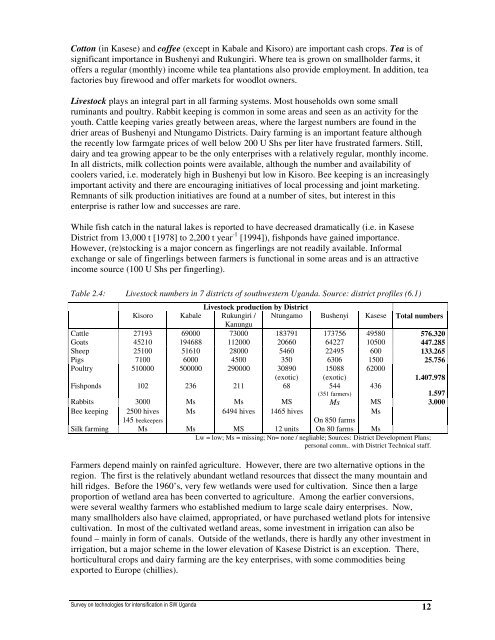Technologies for intensification in SW Uganda ... - Foodnet - cgiar
Technologies for intensification in SW Uganda ... - Foodnet - cgiar
Technologies for intensification in SW Uganda ... - Foodnet - cgiar
Create successful ePaper yourself
Turn your PDF publications into a flip-book with our unique Google optimized e-Paper software.
Cotton (<strong>in</strong> Kasese) and coffee (except <strong>in</strong> Kabale and Kisoro) are important cash crops. Tea is of<br />
significant importance <strong>in</strong> Bushenyi and Rukungiri. Where tea is grown on smallholder farms, it<br />
offers a regular (monthly) <strong>in</strong>come while tea plantations also provide employment. In addition, tea<br />
factories buy firewood and offer markets <strong>for</strong> woodlot owners.<br />
Livestock plays an <strong>in</strong>tegral part <strong>in</strong> all farm<strong>in</strong>g systems. Most households own some small<br />
rum<strong>in</strong>ants and poultry. Rabbit keep<strong>in</strong>g is common <strong>in</strong> some areas and seen as an activity <strong>for</strong> the<br />
youth. Cattle keep<strong>in</strong>g varies greatly between areas, where the largest numbers are found <strong>in</strong> the<br />
drier areas of Bushenyi and Ntungamo Districts. Dairy farm<strong>in</strong>g is an important feature although<br />
the recently low farmgate prices of well below 200 U Shs per liter have frustrated farmers. Still,<br />
dairy and tea grow<strong>in</strong>g appear to be the only enterprises with a relatively regular, monthly <strong>in</strong>come.<br />
In all districts, milk collection po<strong>in</strong>ts were available, although the number and availability of<br />
coolers varied, i.e. moderately high <strong>in</strong> Bushenyi but low <strong>in</strong> Kisoro. Bee keep<strong>in</strong>g is an <strong>in</strong>creas<strong>in</strong>gly<br />
important activity and there are encourag<strong>in</strong>g <strong>in</strong>itiatives of local process<strong>in</strong>g and jo<strong>in</strong>t market<strong>in</strong>g.<br />
Remnants of silk production <strong>in</strong>itiatives are found at a number of sites, but <strong>in</strong>terest <strong>in</strong> this<br />
enterprise is rather low and successes are rare.<br />
While fish catch <strong>in</strong> the natural lakes is reported to have decreased dramatically (i.e. <strong>in</strong> Kasese<br />
District from 13,000 t [1978] to 2,200 t year -1 [1994]), fishponds have ga<strong>in</strong>ed importance.<br />
However, (re)stock<strong>in</strong>g is a major concern as f<strong>in</strong>gerl<strong>in</strong>gs are not readily available. In<strong>for</strong>mal<br />
exchange or sale of f<strong>in</strong>gerl<strong>in</strong>gs between farmers is functional <strong>in</strong> some areas and is an attractive<br />
<strong>in</strong>come source (100 U Shs per f<strong>in</strong>gerl<strong>in</strong>g).<br />
Table 2.4: Livestock numbers <strong>in</strong> 7 districts of southwestern <strong>Uganda</strong>. Source: district profiles (6.1)<br />
Livestock production by District<br />
Kisoro Kabale Rukungiri /<br />
Kanungu<br />
Ntungamo Bushenyi Kasese Total numbers<br />
Cattle 27193 69000 73000 183791 173756 49580 576.320<br />
Goats 45210 194688 112000 20660 64227 10500 447.285<br />
Sheep 25100 51610 28000 5460 22495 600 133.265<br />
Pigs 7100 6000 4500 350 6306 1500 25.756<br />
Poultry 510000 500000 290000 30890 15088 62000<br />
(exotic) (exotic)<br />
1.407.978<br />
Fishponds 102 236 211 68 544<br />
(351 farmers)<br />
436<br />
1.597<br />
Rabbits 3000 Ms Ms MS Ms MS 3.000<br />
Bee keep<strong>in</strong>g 2500 hives Ms 6494 hives 1465 hives<br />
Ms<br />
145 beekeepers<br />
On 850 farms<br />
Silk farm<strong>in</strong>g Ms Ms MS 12 units On 80 farms Ms<br />
Lw = low; Ms = miss<strong>in</strong>g; Nn= none / negliable; Sources: District Development Plans;<br />
personal comm.. with District Technical staff.<br />
Farmers depend ma<strong>in</strong>ly on ra<strong>in</strong>fed agriculture. However, there are two alternative options <strong>in</strong> the<br />
region. The first is the relatively abundant wetland resources that dissect the many mounta<strong>in</strong> and<br />
hill ridges. Be<strong>for</strong>e the 1960’s, very few wetlands were used <strong>for</strong> cultivation. S<strong>in</strong>ce then a large<br />
proportion of wetland area has been converted to agriculture. Among the earlier conversions,<br />
were several wealthy farmers who established medium to large scale dairy enterprises. Now,<br />
many smallholders also have claimed, appropriated, or have purchased wetland plots <strong>for</strong> <strong>in</strong>tensive<br />
cultivation. In most of the cultivated wetland areas, some <strong>in</strong>vestment <strong>in</strong> irrigation can also be<br />
found – ma<strong>in</strong>ly <strong>in</strong> <strong>for</strong>m of canals. Outside of the wetlands, there is hardly any other <strong>in</strong>vestment <strong>in</strong><br />
irrigation, but a major scheme <strong>in</strong> the lower elevation of Kasese District is an exception. There,<br />
horticultural crops and dairy farm<strong>in</strong>g are the key enterprises, with some commodities be<strong>in</strong>g<br />
exported to Europe (chillies).<br />
12
















